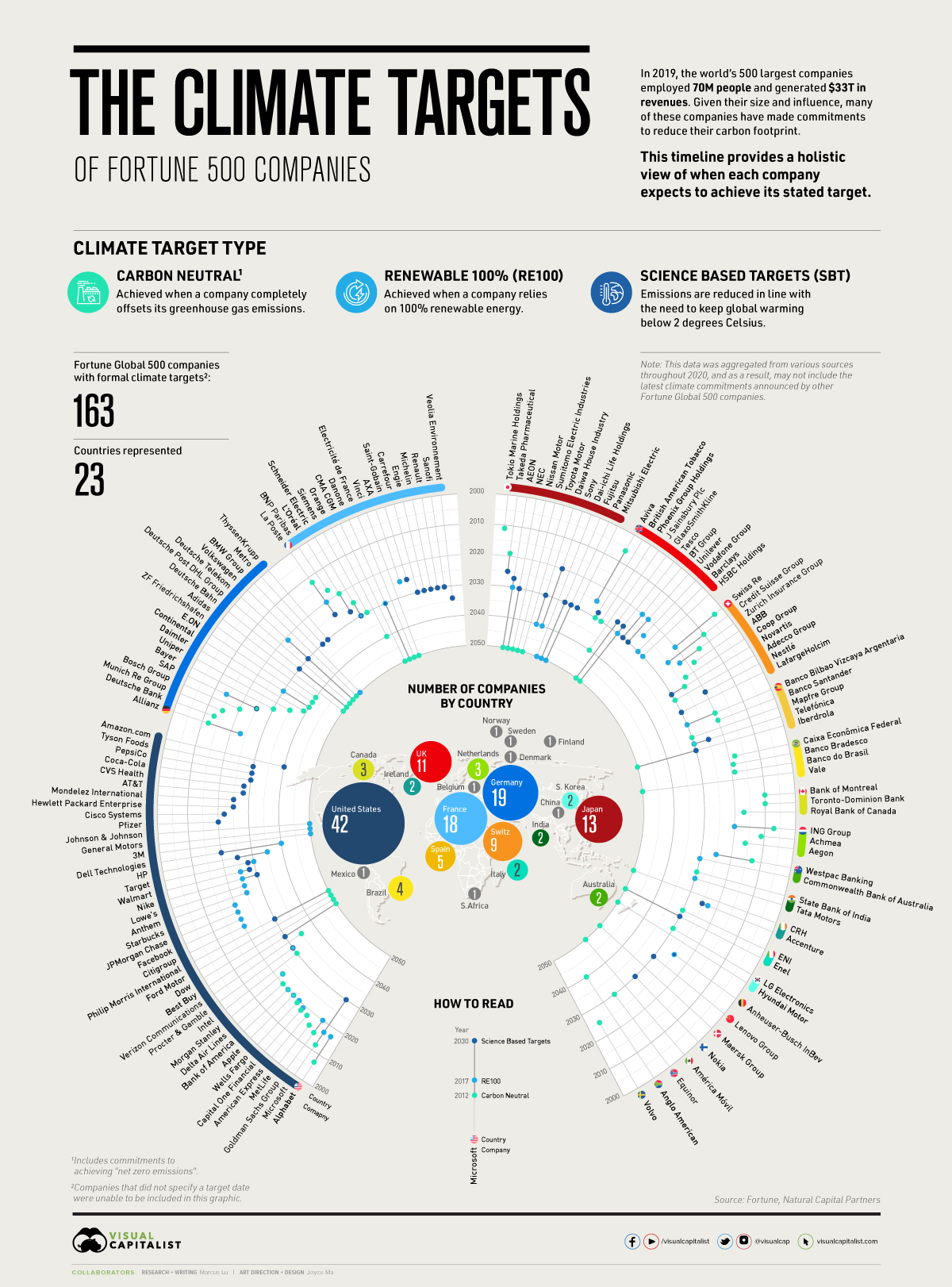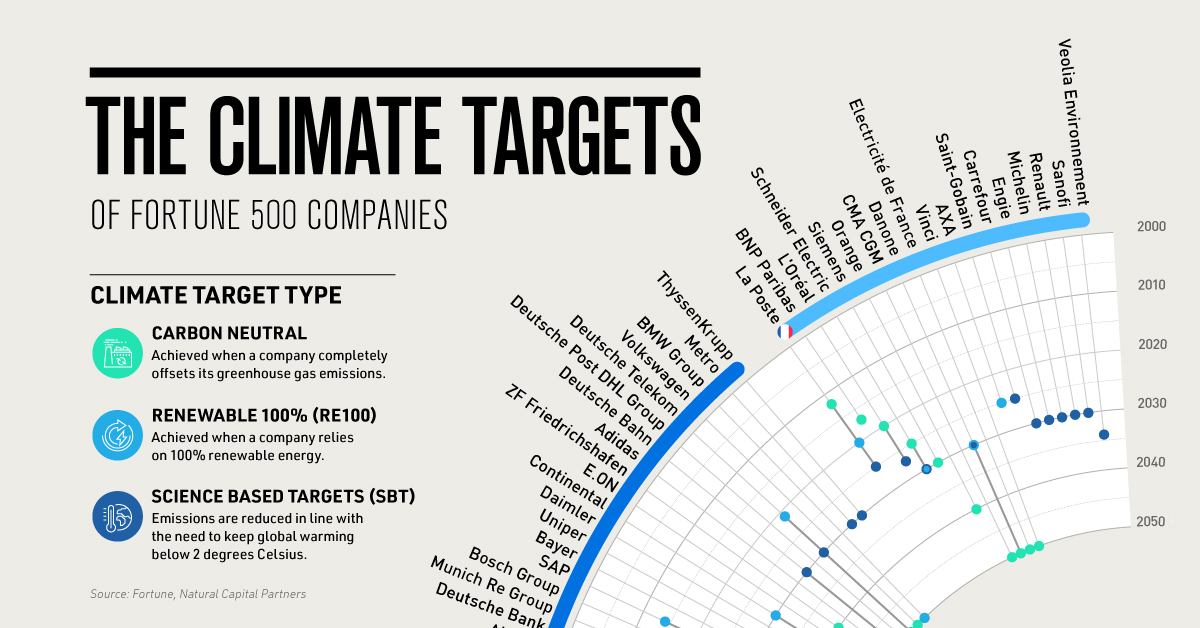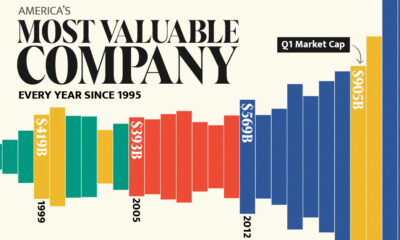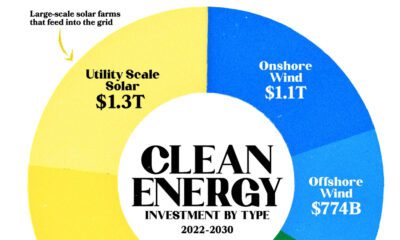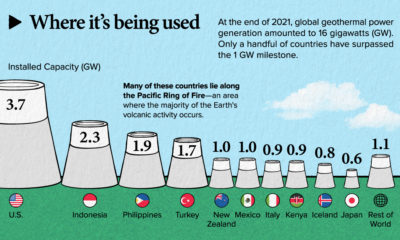Green
Visualizing the Climate Targets of Fortune 500 Companies
View the full-resolution version of this infographic
Visualized: The Climate Targets of Fortune 500 Companies
View the high-resolution version of this infographic by clicking here
The Fortune Global 500 is a ranking of the world’s 500 largest companies by revenue. In 2019, this influential group employed 70 million people and generated revenues of over $33 trillion.
Given their size and influence, many of these companies are taking climate action quite seriously. For example, 30% of the group have either achieved a climate goal or are publicly committed to doing so by 2030—a significant increase from just 6% in 2016.
In this infographic, we’ve used data from Natural Capital Partners to provide a holistic view of when Fortune Global 500 companies plan to meet their stated climate goals.
Climate Action Takes Several Forms
When taking climate action, businesses have a variety of targets they can pursue. Three of the most common ones include carbon neutrality, RE100, and science based targets (SBT).
| Climate target type | Description |
|---|---|
| Carbon neutral | Achieved when a company completely offsets its greenhouse gas (GHG) emissions. |
| RE100 | Achieved when a company relies on 100% renewable energy. |
| Science based targets (SBT) | Emissions are reduced in line with the need to keep global warming below 2ºC. |
After choosing a target, businesses can also set a date for when they intend to achieve it. As the above graphic shows, many companies are targeting 2030, a year that is frequently touted as a deadline for meeting the goals of the Paris Agreement.
A fourth target known as “net zero emissions” is also used, though its exact definition tends to vary. For the purposes of this infographic, we’ve considered a commitment to net zero emissions to be the same as achieving carbon neutrality.
A Complete Overview
The following table summarizes the climate actions of Fortune Global 500 companies. Firms that made commitments without a target date have been noted in the table with a “C”.
| Company Name | Headquarters | Carbon Neutral (target date) | RE100 (target date) | SBT (target date) |
|---|---|---|---|---|
| Commonwealth Bank of Australia | 🇦🇺Australia | 2030 | ||
| Westpac Banking | 🇦🇺Australia | 2013 | 2025 | |
| Woolworths Group | 🇦🇺Australia | C | ||
| Anheuser-Busch InBev | 🇧🇪Belgium | 2025 | 2025 | |
| Banco Bradesco | 🇧🇷Brazil | 2019 | ||
| Banco do Brasil | 🇧🇷Brazil | 2019 | ||
| Caixa Econômica Federal | 🇧🇷Brazil | 2018 | ||
| Vale | 🇧🇷Brazil | 2050 | ||
| Bank of Montreal | 🇨🇦Canada | 2010 | ||
| Royal Bank of Canada | 🇨🇦Canada | 2017 | ||
| Toronto-Dominion Bank | 🇨🇦Canada | 2010 | ||
| Lenovo Group | 🇨🇳China | 2030 | ||
| Xiamen ITG Holding Group | 🇨🇳China | C | ||
| Maersk Group | 🇩🇰Denmark | 2050 | ||
| Nokia | 🇫🇮Finland | 2030 | ||
| Auchan Holding | 🇫🇷France | |||
| AXA | 🇫🇷France | 2025 | ||
| BNP Paribas | 🇫🇷France | 2017 | ||
| Carrefour | 🇫🇷France | 2030 | ||
| CMA CGM | 🇫🇷France | 2050 | ||
| Crédit Agricole | 🇫🇷France | C | ||
| Danone | 🇫🇷France | 2050 | 2030 | 2030 |
| Electricité de France | 🇫🇷France | 2050 | ||
| Engie | 🇫🇷France | 2030 | ||
| L'Oréal | 🇫🇷France | 2020 | 2027 | |
| La Poste | 🇫🇷France | 2012 | 2020 | 2025 |
| Michelin | 🇫🇷France | 2030 | ||
| Orange | 🇫🇷France | 2040 | ||
| Renault | 🇫🇷France | 2030 | ||
| Saint-Gobain | 🇫🇷France | 2025 | ||
| Sanofi | 🇫🇷France | 2030 | ||
| Schneider Electric | 🇫🇷France | 2025 | 2030 | 2030 |
| Siemens | 🇫🇷France | 2030 | ||
| Société Générale | 🇫🇷France | C | ||
| Veolia Environnement | 🇫🇷France | 2034 | ||
| Vinci | 🇫🇷France | 2050 | ||
| Adidas | 🇩🇪Germany | 2050 | ||
| Allianz | 🇩🇪Germany | 2012 | 2023 | |
| Bayer | 🇩🇪Germany | 2030 | ||
| BMW Group | 🇩🇪Germany | 2050 | ||
| Bosch Group | 🇩🇪Germany | 2020 | ||
| Continental | 🇩🇪Germany | 2040 | 2030 | |
| Daimler | 🇩🇪Germany | 2039 | ||
| Deutsche Bahn | 🇩🇪Germany | 2050 | 2030 | |
| Deutsche Bank | 🇩🇪Germany | 2013 | ||
| Deutsche Post DHL Group | 🇩🇪Germany | 2050 | ||
| Deutsche Telekom | 🇩🇪Germany | 2050 | 2021 | 2030 |
| E.ON | 🇩🇪Germany | 2040 | ||
| Metro | 🇩🇪Germany | 2030 | ||
| Munich Re Group | 🇩🇪Germany | 2015 | ||
| SAP | 🇩🇪Germany | 2025 | 2014 | 2025 |
| ThyssenKrupp | 🇩🇪Germany | 2030 | ||
| Uniper | 🇩🇪Germany | 2035 | ||
| Volkswagen | 🇩🇪Germany | 2050 | ||
| ZF Friedrichshafen | 🇩🇪Germany | 2040 | ||
| State Bank of India | 🇮🇳India | 2030 | ||
| Tata Motors | 🇮🇳India | 2030 | ||
| Accenture | 🇮🇪Ireland | 2023 | 2025 | |
| CRH | 🇮🇪Ireland | 2050 | ||
| Johnson Controls International | 🇮🇪Ireland | C | ||
| Enel | 🇮🇹Italy | 2050 | 2030 | |
| ENI | 🇮🇹Italy | 2030 | ||
| AEON | 🇯🇵Japan | 2050 | 2030 | 2027 |
| Dai-ichi Life Holdings | 🇯🇵Japan | 2050 | ||
| Daiwa House Industry | 🇯🇵Japan | 2040 | 2030 | |
| Fujitsu | 🇯🇵Japan | 2050 | 2030 | |
| Hitachi | 🇯🇵Japan | C | ||
| Mitsubishi Electric | 🇯🇵Japan | 2030 | ||
| NEC | 🇯🇵Japan | 2050 | 2030 | |
| Nissan Motor | 🇯🇵Japan | 2050 | ||
| Panasonic | 🇯🇵Japan | 2050 | 2030 | |
| Sompo Holdings | 🇯🇵Japan | C | ||
| Sony | 🇯🇵Japan | 2040 | 2020 | |
| Sumitomo Electric Industries | 🇯🇵Japan | 2050 | ||
| Takeda Pharmaceutical | 🇯🇵Japan | 2019 | 2025 | |
| Tokio Marine Holdings | 🇯🇵Japan | 2011 | ||
| Toshiba | 🇯🇵Japan | |||
| Toyota Motor | 🇯🇵Japan | 2050 | ||
| América Móvil | 🇲🇽Mexico | 2050 | ||
| Achmea | 🇳🇱Netherlands | 2011 | ||
| Aegon | 🇳🇱Netherlands | 2016 | ||
| Heineken Holding | 🇳🇱Netherlands | C | ||
| ING Group | 🇳🇱Netherlands | 2007 | 2020 | |
| Equinor | 🇳🇴Norway | 2030 | ||
| Anglo American | 🇿🇦South Africa | 2040 | ||
| Hyundai Motor | 🇰🇷South Korea | 2050 | ||
| LG Electronics | 🇰🇷South Korea | 2030 | ||
| Banco Bilbao Vizcaya Argentaria | 🇪🇸Spain | 2020 | 2030 | |
| Banco Santander | 🇪🇸Spain | 2020 | ||
| Iberdrola | 🇪🇸Spain | 2050 | 2030 | |
| Inditex | 🇪🇸Spain | C | ||
| Mapfre Group | 🇪🇸Spain | 2030 | ||
| Naturgy Energy Group | 🇪🇸Spain | C | ||
| Telefónica | 🇪🇸Spain | 2030 | 2030 | 2025 |
| Volvo | 🇸🇪Sweden | 2025 | ||
| ABB | 🇨🇭Switzerland | 2018 | ||
| Adecco Group | 🇨🇭Switzerland | 2030 | ||
| Coop Group | 🇨🇭Switzerland | 2023 | ||
| Credit Suisse Group | 🇨🇭Switzerland | 2010 | 2025 | |
| LafargeHolcim | 🇨🇭Switzerland | 2030 | ||
| Migros Group | 🇨🇭Switzerland | C | ||
| Nestlé | 🇨🇭Switzerland | 2020 | ||
| Novartis | 🇨🇭Switzerland | 2025 | 2030 | |
| Swiss Re | 🇨🇭Switzerland | 2003 | 2020 | |
| Zurich Insurance Group | 🇨🇭Switzerland | 2014 | 2022 | |
| Fubon Financial Holding | 🇹🇼Taiwan | C | ||
| PTT | 🇹🇭Thailand | C | ||
| Aviva | 🇬🇧UK | 2006 | 2025 | |
| Barclays | 🇬🇧UK | 2030 | ||
| British American Tobacco | 🇬🇧UK | 2030 | 2028 | |
| BT Group | 🇬🇧UK | 2020 | 2030 | |
| Compass Group | 🇬🇧UK | C | ||
| GlaxoSmithKline | 🇬🇧UK | 2050 | 2027 | |
| HSBC Holdings | 🇬🇧UK | 2030 | ||
| J. Sainsbury | 🇬🇧UK | 2040 | ||
| Linde | 🇬🇧UK | C | ||
| Phoenix Group Holdings | 🇬🇧UK | 2030 | ||
| Tesco | 🇬🇧UK | 2050 | 2030 | 2027 |
| Unilever | 🇬🇧UK | 2020 | 2030 | |
| Vodafone Group | 🇬🇧UK | 2025 | ||
| 3M | 🇺🇸USA | 2050 | ||
| Alphabet | 🇺🇸USA | 2007 | 2017 | |
| Amazon.com | 🇺🇸USA | 2040 | 2025 | 2040 |
| American Express | 🇺🇸USA | 2018 | ||
| Anthem | 🇺🇸USA | 2025 | ||
| Apple | 🇺🇸USA | 2020 | 2020 | |
| AT&T | 🇺🇸USA | 2028 | ||
| Bank of America | 🇺🇸USA | 2020 | 2020 | |
| Best Buy | 🇺🇸USA | 2050 | 2030 | |
| Capital One Financial | 🇺🇸USA | 2018 | 2019 | |
| Cisco Systems | 🇺🇸USA | 2022 | ||
| Citigroup | 🇺🇸USA | 2020 | ||
| Coca-Cola | 🇺🇸USA | 2030 | ||
| CVS Health | 🇺🇸USA | 2028 | ||
| Dell Technologies | 🇺🇸USA | 2040 | 2020 | |
| Delta Air Lines | 🇺🇸USA | 2020 | ||
| Dow | 🇺🇸USA | 2050 | ||
| 🇺🇸USA | 2020 | |||
| Ford Motor | 🇺🇸USA | 2050 | ||
| General Motors | 🇺🇸USA | 2050 | ||
| Goldman Sachs Group | 🇺🇸USA | 2015 | 2020 | |
| Hewlett Packard Enterprise | 🇺🇸USA | 2025 | ||
| HP | 🇺🇸USA | 2035 | 2025 | |
| Intel | 🇺🇸USA | 2030 | ||
| Johnson & Johnson | 🇺🇸USA | 2050 | ||
| JPMorgan Chase | 🇺🇸USA | 2020 | ||
| Lowe's | 🇺🇸USA | 2025 | ||
| MetLife | 🇺🇸USA | 2016 | ||
| Microsoft | 🇺🇸USA | 2012 | 2017 | 2030 |
| Mondelez International | 🇺🇸USA | 2025 | ||
| Morgan Stanley | 🇺🇸USA | 2022 | 2022 | |
| Nike | 🇺🇸USA | 2025 | 2030 | |
| PepsiCo | 🇺🇸USA | 2030 | ||
| Pfizer | 🇺🇸USA | 2020 | ||
| Philip Morris International | 🇺🇸USA | 2050 | 2030 | |
| Procter & Gamble | 🇺🇸USA | 2030 | 2030 | 2030 |
| Schlumberger | 🇺🇸USA | C | ||
| Starbucks | 🇺🇸USA | 2020 | ||
| Target | 🇺🇸USA | 2030 | 2028 | |
| Tyson Foods | 🇺🇸USA | 2030 | ||
| Verizon Communications | 🇺🇸USA | 2035 | ||
| Walmart | 🇺🇸USA | 2025 | 2027 | |
| Wells Fargo | 🇺🇸USA | 2019 | 2020 |
Note: This data was aggregated from various sources throughout 2020, and as a result, may not include the latest climate commitments announced by companies within the Fortune Global 500.
As of October 2020, 163 companies from the Fortune Global 500 have publicly committed to achieving at least one of these climate targets. That represents 32.6% of the total group.
The most common target is carbon neutrality, which has 91 companies on board. In second place is science based targets (SBT), which has 74 companies committed—of those, 16 have not declared a target date. RE100 was the least common, with 56 companies committed. Because some companies are committed to multiple targets, these figures add to more than 163.
Climate Action is on the Rise
Private-sector awareness around climate change and other sustainability issues has gained strong momentum in recent years.
Since 2011, the number of S&P 500 companies publishing sustainability reports increased from 20% in 2011, to 90% in 2019. This was likely due to investor demand and a broader acceptance of environmental, social, and governance (ESG) criteria.
Governments around the world are also taking a more proactive approach to climate action. The Biden administration, for example, seeks to make a $2 trillion investment to help a variety of U.S. industries become more sustainable.
“We have the opportunity to build a more resilient, sustainable economy – one that will put the United States on an irreversible path to achieve net-zero emissions…by no later than 2050.”
– Biden-Harris campaign
America’s goal of reaching net-zero emissions by 2050 is shared with a handful of other advanced economies, including Japan and the EU. The UK has taken these pledges one step further, becoming the first G7 country to pass a law that requires itself to bring emissions to net zero by 2050.
Green
How Carbon Credits Can Help Close the Climate Funding Gap
To keep a 1.5℃ world within reach, global emissions need to fall by as much as 45% by 2030, and carbon credits could help close the gap.
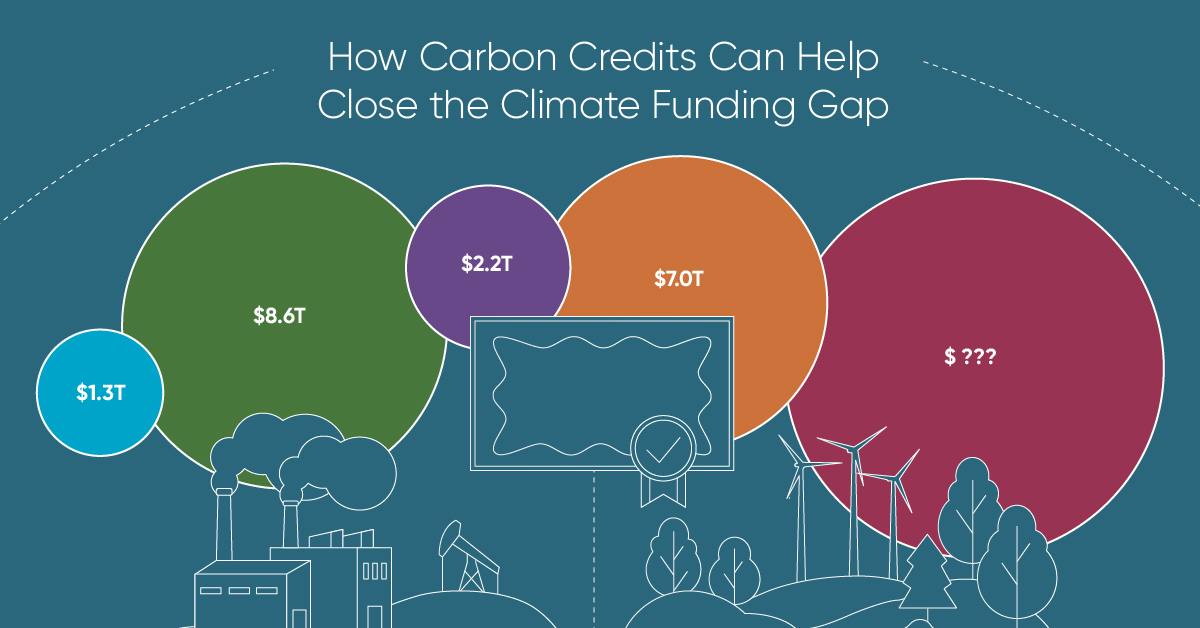
How Carbon Credits Can Help Close the Climate Funding Gap
Governments around the world have committed to the goals of the Paris Agreement, but their climate pledges are insufficient. To keep a 1.5℃ world within reach, global emissions need to fall by as much as 45% by 2030.
Bold and immediate action is essential, but so are resources that will make it happen.
In this graphic, we have partnered with Carbon Streaming to look at the role that the voluntary carbon market and carbon credits can play in closing that gap.
More Funds are Needed for Climate Finance
According to data from the Climate Policy Initiative, climate finance, which includes funds for both adaptation and mitigation, needs to increase at least five-fold, from $1.3T in 2021/2022, to an average $8.6T annually until 2030, and then to just over $10T in the two decades leading up to 2050.
That adds up to a very large number, but consider that in 2022, $7.0T went to fossil fuel subsidies, which almost covers the annual estimated outlay. And the world has shown that when pressed, governments can come up with the money, if the global pandemic is any indication.
Mobilizing Carbon Finance to the Developing World
But the same cannot be said of the developing world, where debt, inequality, and poverty reduce the ability of governments to act. And this is where carbon credits can play an important role. According to analyses from Ecosystem Marketplace, carbon credits help move capital from developed countries, to where funds are needed in the developing world.
For example, in 2019, 69.2% of the carbon credits by volume in the voluntary carbon market were purchased by buyers in Europe, and nearly a third from North America. Compare that to over 90% of the volume of carbon credits sold in the voluntary carbon market in 2022 came from projects that were located outside of those two regions.
Carbon Credits Can Complement Decarbonization Efforts
Carbon credits can also complement decarbonization efforts in the corporate world, where more and more companies have been signing up to reduce emissions. According to the 2022 monitoring report from the Science Based Targets initiative, 4,230 companies around the world had approved targets and commitments, which represented an 88% increase from the prior year. However, as of year end 2022, combined scope 1 and 2 emissions covered by science-based targets totaled approximately 2 GtCO2e, which represents just a fraction of global emissions.
The fine print is that this is just scope 1 and 2 emissions, and doesn’t include scope 3 emissions, which can account for more than 70% of a company’s total emissions. And as these emissions come under greater and greater scrutiny the closer we get to 2030 and beyond, the voluntary carbon credit market could expand exponentially to help meet the need to compensate for these emissions.
Potential Carbon Credit Market Size in 2030
OK, but how big? In 2022, the voluntary carbon credit market was around $2B, but some analysts predict that it could grow to between $5–250 billion by 2030.
| Firm | Low Estimate | High Estimate |
|---|---|---|
| Bain & Company | $15B | $30B |
| Barclays | N/A | $250B |
| Citigroup | $5B | $50B |
| McKinsey & Company | $5B | $50B |
| Morgan Stanley | N/A | $100B |
| Shell / Boston Consulting Group | $10B | $40B |
Morgan Stanley and Barclays were the most bullish on the size of the voluntary carbon credit market in 2030, but the latter firm was even more optimistic about 2050, and predicted that the voluntary carbon credit market could grow to a colossal $1.5 trillion.
Carbon Streaming is Focused on Carbon Credit Integrity
Ultimately, carbon credits could have an important role to play in marshaling the resources needed to keep the world on track to net zero by 2050, and avoiding the worst consequences of a warming world.
Carbon Streaming uses streaming transactions, a proven and flexible funding model, to scale high-integrity carbon credit projects to advance global climate action and UN Sustainable Development Goals.

Learn more at www.carbonstreaming.com.

-

 Green1 week ago
Green1 week agoRanking the Top 15 Countries by Carbon Tax Revenue
This graphic highlights France and Canada as the global leaders when it comes to generating carbon tax revenue.
-

 Green1 week ago
Green1 week agoRanked: The Countries With the Most Air Pollution in 2023
South Asian nations are the global hotspot for pollution. In this graphic, we rank the world’s most polluted countries according to IQAir.
-

 Environment2 weeks ago
Environment2 weeks agoTop Countries By Forest Growth Since 2001
One country is taking reforestation very seriously, registering more than 400,000 square km of forest growth in two decades.
-

 Green3 weeks ago
Green3 weeks agoRanked: Top Countries by Total Forest Loss Since 2001
The country with the most forest loss since 2001 lost as much forest cover as the next four countries combined.
-

 Markets2 months ago
Markets2 months agoThe World’s Top Cocoa Producing Countries
Here are the largest cocoa producing countries globally—from Côte d’Ivoire to Brazil—as cocoa prices hit record highs.
-

 Environment2 months ago
Environment2 months agoCharted: Share of World Forests by Country
We visualize which countries have the biggest share of world forests by area—and while country size plays a factor, so too, does the environment.
-

 Markets1 week ago
Markets1 week agoU.S. Debt Interest Payments Reach $1 Trillion
-

 Markets2 weeks ago
Markets2 weeks agoRanked: The Most Valuable Housing Markets in America
-

 Money2 weeks ago
Money2 weeks agoWhich States Have the Highest Minimum Wage in America?
-

 AI2 weeks ago
AI2 weeks agoRanked: Semiconductor Companies by Industry Revenue Share
-

 Markets2 weeks ago
Markets2 weeks agoRanked: The World’s Top Flight Routes, by Revenue
-

 Countries2 weeks ago
Countries2 weeks agoPopulation Projections: The World’s 6 Largest Countries in 2075
-

 Markets2 weeks ago
Markets2 weeks agoThe Top 10 States by Real GDP Growth in 2023
-

 Money2 weeks ago
Money2 weeks agoThe Smallest Gender Wage Gaps in OECD Countries

